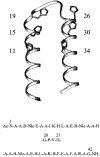Biocatalysts Based on Peptide and Peptide Conjugate Nanostructures
- PMID: 33843196
- PMCID: PMC8154259
- DOI: 10.1021/acs.biomac.1c00240
Biocatalysts Based on Peptide and Peptide Conjugate Nanostructures
Abstract
Peptides and their conjugates (to lipids, bulky N-terminals, or other groups) can self-assemble into nanostructures such as fibrils, nanotubes, coiled coil bundles, and micelles, and these can be used as platforms to present functional residues in order to catalyze a diversity of reactions. Peptide structures can be used to template catalytic sites inspired by those present in natural enzymes as well as simpler constructs using individual catalytic amino acids, especially proline and histidine. The literature on the use of peptide (and peptide conjugate) α-helical and β-sheet structures as well as turn or disordered peptides in the biocatalysis of a range of organic reactions including hydrolysis and a variety of coupling reactions (e.g., aldol reactions) is reviewed. The simpler design rules for peptide structures compared to those of folded proteins permit ready ab initio design (minimalist approach) of effective catalytic structures that mimic the binding pockets of natural enzymes or which simply present catalytic motifs at high density on nanostructure scaffolds. Research on these topics is summarized, along with a discussion of metal nanoparticle catalysts templated by peptide nanostructures, especially fibrils. Research showing the high activities of different classes of peptides in catalyzing many reactions is highlighted. Advances in peptide design and synthesis methods mean they hold great potential for future developments of effective bioinspired and biocompatible catalysts.
Conflict of interest statement
The author declares no competing financial interest.
Figures
















Similar articles
-
Development of Selective Peptide Catalysts with Secondary Structural Frameworks.Acc Chem Res. 2017 Oct 17;50(10):2429-2439. doi: 10.1021/acs.accounts.7b00211. Epub 2017 Sep 5. Acc Chem Res. 2017. PMID: 28872296
-
α-Helical Peptide-Gold Nanoparticle Hybrids: Synthesis, Characterization, and Catalytic Activity.Protein Pept Lett. 2018;25(1):56-63. doi: 10.2174/0929866525666171214113324. Protein Pept Lett. 2018. PMID: 29237364
-
Self-assembly of Functional Nanostructures by Short Helical Peptide Building Blocks.Protein Pept Lett. 2019;26(2):88-97. doi: 10.2174/0929866525666180917163142. Protein Pept Lett. 2019. PMID: 30227810 Free PMC article. Review.
-
Photothermally switchable peptide nanostructures towards modulating catalytic hydrolase activity.Nanoscale. 2021 Aug 21;13(31):13401-13409. doi: 10.1039/d1nr03655f. Epub 2021 Jul 29. Nanoscale. 2021. PMID: 34477745
-
Peptides for Silica Precipitation: Amino Acid Sequences for Directing Mineralization.Protein Pept Lett. 2018;25(1):15-24. doi: 10.2174/0929866525666171214111007. Protein Pept Lett. 2018. PMID: 29237367 Review.
Cited by
-
Supramolecular Gels as Active Tools for Reaction Engineering.Angew Chem Int Ed Engl. 2025 Jun 10;64(24):e202502053. doi: 10.1002/anie.202502053. Epub 2025 Apr 7. Angew Chem Int Ed Engl. 2025. PMID: 40153521 Free PMC article. Review.
-
Engineering and Exploiting Immobilized Peptide Organocatalysts for Modern Synthesis.Molecules. 2025 Jun 9;30(12):2517. doi: 10.3390/molecules30122517. Molecules. 2025. PMID: 40572483 Free PMC article. Review.
-
Peptide nanozymes: An emerging direction for functional enzyme mimics.Bioact Mater. 2024 Sep 4;42:284-298. doi: 10.1016/j.bioactmat.2024.08.033. eCollection 2024 Dec. Bioact Mater. 2024. PMID: 39285914 Free PMC article. Review.
-
Micellization of Lipopeptides Containing Toll-like Receptor Agonist and Integrin Binding Sequences.ACS Appl Mater Interfaces. 2024 Dec 18;16(50):68713-68723. doi: 10.1021/acsami.4c18165. Epub 2024 Dec 9. ACS Appl Mater Interfaces. 2024. PMID: 39651938 Free PMC article. Review.
-
Self-assembly of benzophenone-diphenylalanine conjugate into a nanostructured photocatalyst.Chem Commun (Camb). 2023 Jun 15;59(49):7619-7622. doi: 10.1039/d3cc01673k. Chem Commun (Camb). 2023. PMID: 37254947 Free PMC article.
References
-
- Bugg T. D. H.Introduction to Enzyme and Coenzyme Chemistry; Wiley: Chichester, UK, 2012.
-
- Palmer T.; Bonner P. L.. Enzymes: Biochemistry, Biotechnology, Clinical Chemistry; Woodhead Publishing: Cambridge, 2007.
-
- Engel P.Enzymes. A Very Short Introduction.; Oxford University Press: Oxford, 2020.
-
- Santoso S. S.; Vauthey S.; Zhang S. Structures, function and applications of amphiphilic peptides. Curr. Opin. Colloid Interface Sci. 2002, 7, 262–266. 10.1016/S1359-0294(02)00072-9. - DOI
Publication types
MeSH terms
Substances
LinkOut - more resources
Full Text Sources
Other Literature Sources

